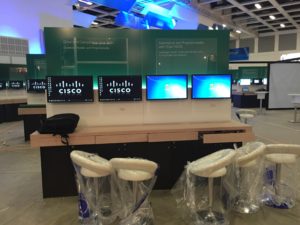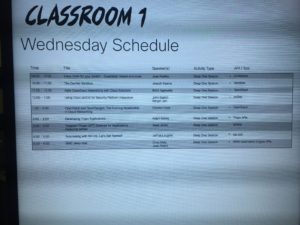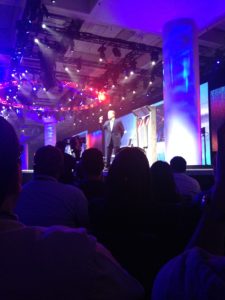We’ve moved into a wireless world, which is too bad for me because I love, more than anything, wiring. I miss the days of good old Cat 3 cable, T1 lines, and ISDN BRIs. I miss 66 blocks, punch down tools, cross-connect wire, and tone/probe kits. And butt sets. Especially butt sets. Now I just have to add random wall receptacles around my house since, thank goodness, 120 volts cannot be delivered wirelessly. But phone and network wiring was much more fun.
I first got interested in wiring when I was working at a small museum exhibit design and fabrication company in Marin, California. One day, I had to have a new phone line installed, and I called in Pacific Bell to do the work. Under the receptionist’s desk was a wall plate with two RJ-11 jacks, already in use. “There aren’t any free jacks,” I told the phone guy.
“It doesn’t matter, as long as there is enough wire,” was his cryptic response. I let him do his work, and when he was done I saw a little surface-mount RJ11 jack on the wall. It had two blue and yellow wires running from it, going underneath the existing faceplate and somehow into the wall. How on earth did he do that? I remember thinking.
I waited until everyone went home. I unscrewed the faceplate and found that the blue/yellow wire pair was spliced to the brown pair of wires in the cable that serviced the existing jacks. The splice was a 3M UR-type, which looked like a piece of candy. I was captivated. How did he know where the brown wires went? Where did the incoming phone line enter the building? How did he connect them up?
The fun thing about the days before ubiquitous Internet was that you couldn’t get answers immediately. When I found the 66-type punchdown blocks that formed our little MDF, I couldn’t Google the part number to figure out what they were. Google didn’t exist. I had no idea how to terminate a wire on one of them. While thumbing through a Jensen Tools catalog our purchasing agent had I got an idea of how it worked. There, I saw listed a “66 punch-down tool” and I had noticed the numbers “66” on the block. OK, so they go together and the wire gets in the clip by “punching down.”
I didn’t have the money to afford a punch-down tool. So I got a pair of pliers and a pair of forceps and started doing terminations myself, guiding the wire into the clip. Sure, sparks were flying, but phone systems are robust, aren’t they?
It turns out not as robust as you might think. Back in the day, phone lines provided by the phone company (POTS service) were indeed robust and could handle quite a bit of sparking and shorting. But the Nitsuko (emphasis on the “suk”) system we used did not take kindly to my laissez-faire approach to wiring. One day, while doing a move, I shorted out a couple terminals and all the phones in the building went out. I came out of the closet with pliers in hand and everyone knew what happened. This being before cell phones, business was done for the day. Luckily we got our phone company out to replace the bad part, and they did it under warranty. It was at this point I invested in a proper punch-down tool and learned how to wire correctly.
I saved up a lot of money and eventually got a test set, otherwise known as a “butt set”. The butt set looks like an oversized telephone handset, and is the official sign of a telco wiring guy. It also was my passport into telephone wiring closets–when a security guard sees you have a butt set, they just assume you’re a real phone guy.
I practiced my technique in my father’s 1910-era house. The decades brought with them layers of phone wiring, including two 50-pair feeder cables and a 66-style punch-down block. Why and how the feeder cables ended up in a house with 3 phone lines is a mystery to this day. But I used the 66-block for practice and dissected the criss-crossing wires in his house, tracing them out with my trusty tone/probe set.
Wiring skills came in handy many times in my career as a network engineer. I remember one customer I had in the late nineties who had ordered 8 Centrex lines from Pacific Bell. The technician showed up to do the cross-connects, but he was not the sharpest knife in the drawer, did two of them, and left. Using my butt set passport, I got access to the MDF, figured out the right punch-down block that fed to the customer’s suite, and ran the cross-connects myself.
When I worked for the San Francisco Chronicle, we actually had an in-house wiring tech. Her name was Mona Lesa. She couldn’t care less if I did my own wiring, as long as I adhered to her standards. One day I had a frame relay T1 installed in our Sacramento bureau office, and once again, Pac Bell forgot to connect it to the suite. The bureau was located in the Old Senator Office Building across from the state capitol. I got the security guard to let me in to the MDF in the bowels of this historic building. I figured out that one of the interconnects was in the office of a lobbying firm, and the receptionist dutifully let me in to do the wiring. With my butt set I could clip into any of their phone lines and listen to their conversations without them knowing. I didn’t but I was amazed that I could go anywhere to do cross-connects.
On another occasion, a customer of mine had two phone lines installed and had a weird problem. If she picked up one line and dialed the other, she’d hear both ringing and a busy signal at the same time. I found where the Pacific Bell guy had done the cross-connect, and realized he mixed the tip and ring wires for the two phone lines. A couple punches and all fixed.
Phone wiring was always the perfect blend of mind and body to me. To do it you need to work with your hands, but you also need to use your mind. Some wiring closets were rats nests of 24-gauge wires color-coded with more colors than a tie-died shirt. Finding that one pair you needed, and marrying it up to the other end was always a nice diversion from staring at a screen.
Alas, my tools mostly sit unused. Regular POTS lines rarely exist now, and even they aren’t delivered on single copper pairs from the CO switch. PBXs and key systems have gone the way of the dinosaur, replaced by voice-over-IP and now by cellular phones. Nobody wants to be tied to wires anymore, and yet by un-encumbering ourselves in the name of freedom, we’ve paradoxically lost our freedom. When you don’t need to be physically tied to a location for connectivity, you can never escape connectivity. And that’s not entirely a good thing.






